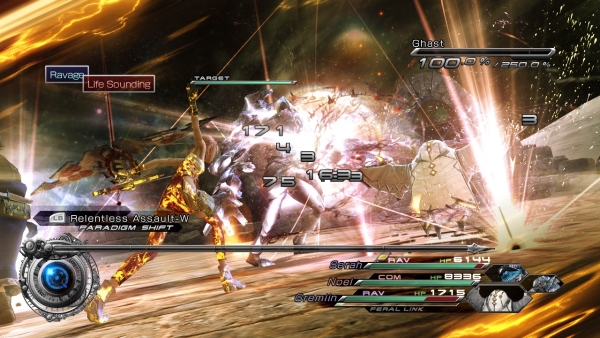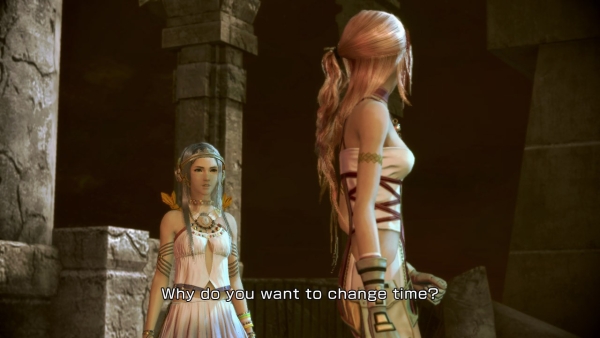
Final Fantasy XIII-2 is a game that has no idea what it’s doing or where it’s going. It’s full of time traveling, paradoxes, role-playing, platforming, and more than a few puzzles to solve. It’s full of changes and alterations, but at the core, it’s very much a sequel – and it shows. It feels like the game is experiencing growing pains, with short bursts of interesting moments infused with utter dullness. Should you take the plunge and go back to Pulse? Or would your money and time be better spent waiting for Operation Rainfall games to hit our shores?
Platforms: PS3 (Version Played), Xbox 360
Publisher: Square Enix
Developer: Square Enix, Tri-Ace
Genre: Time-Traveling JRPG
Release Date: January 31, 2012
ESRB Rating: Teen
Final Fantasy XIII-2 picks up where Final Fantasy XIII left off. Vanille and Fang are holding up the pillar that keeps Cocoon in the air, and the rest of our heroes have all been united with their loved ones. But something has changed – suddenly, no one remembers Lightning being there, and everyone thinks she went into the pillar with Vanille and Fang. Serah, the new main character, fights to put her memories in order.
Final Fantasy XIII-2 really doesn’t know what kind of game it wants to be. It starts out innocently enough, reminding you of the mechanics from the first game. It refreshes you on fighting and Paradigm Shifts, as well as interacting with your environment. There are a few new things as well, of course. Some are subtle – Paradigm Shifting no longer has that pause to show you what each character does when they shift – while others are far more obvious, like the ability to actually jump. (Don’t laugh. I was seriously excited about this!)
You travel through space and time via time gates, which have to be unlocked with Artefacts (their spelling, not mine). By you, I mean Serah and Noel, a new character who has travelled back in time to help Serah find Lightning. Final Fantasy XIII-2 is much more open world than Final Fantasy XIII, but only in that you now have access to the Historia Crux, which allows you to travel through the Pause menu. This is also where you start whenever you turn the game on. There is a linear story involved somewhere in here, but there are lots of sidequests and plenty of places to explore.
The problem with this setup is that it’s very, very easy to go in the “wrong” direction – which, for an open world game, shouldn’t really be an issue. Yet here, it’s glaringly obvious – I ended up stuck in one Episode for hours on end because I had overlooked a time gate that I was supposed to use, and ended up struggling in other places and times, trying to figure out where I was supposed to go.

Setting the game up in this way leads to a lot of frustration. Do I want to try to fight this boss again? Well, I’ve been grinding for hours, so why not? He can still kill me in one shot, so maybe I need to find another way around him. Do I want to take on this sidequest? Not really, but it turns out, after a few more hours poking around, that I have to complete that “sidequest” to progress in the game. Protip: don’t call it a sidequest if it’s a requirement for progress.
The Crystarium has been slightly changed – you still apply your Crystarium Points (basically experience points) to the six different classes, all of which can be unlocked as you level up. But as you go through each class, the amount needed to level up the other classes goes higher and higher – so, for example, if you’ve maxed out all but one of your classes at 99, it takes a lot of CP to unlock just the second level of that other class. I’m at level 65 for the Medic with Serah, but my other classes are nearly maxed out, so I need 1100 points just to go from crystal to crystal.
The game is frustrating, but it feels like it doesn’t have to be. There are aspects of it that really are fun. I love the fact that not only are there wandering monsters again, but fighting monsters gives you Gil, which is the Final Fantasy equivalent of gold. So you can truly grind in this game, unlike in the original, in which you could really only grind in one specific area. Also, sometimes, at the end of a fight, the monster then joins your party. You will have a huge array of monsters by the end of the game, and each monster is a different class. Your “Paradigm Pack” consists of any three monsters you choose. You can then add them to your set Paradigms. For example, Cait Sith is a Medic. If you add him to your pack, you can then add him to your Paradigms – so you can have Serah as a Ravager, Noel as a Commando, and set Cait Sith as your Medic, creating a Diversity Paradigm (this is my favorite one to use). The monsters also have something called a “Feral Link,” which is a meter that builds up while you fight. Once it’s maxed out, you can hit Square to see a special move, some of which are very useful.
Monsters also level in the Crystarium as well, but they use something called “Monster Materials,” which you can obtain as spoils after battles, get as treasure throughout the game, or buy at a shop. (The shop, by the way, is run by a creepy woman dressed as a Chocobo, whose name is Choco-Bobo-Lina. Her voice is super annoying, her dialogue is bizarre, and she is generally icky.) The materials can be used to level up the monsters, but be careful, as some max out below optimal potential. Choose wisely when doling out your materials… or just grind your face off, collect tons of Gil, and buy whatever materials you need.

The good, the bad, the different… nothing really does anything to improve the experience of Final Fantasy XIII-2. I think it’s best described as mediocre crack – I’m addicted to it but it’s just not that great. While the monsters in your party are interesting, all they do is replace the (far more useful) third character from the first game, and the (far less useful) Eidolons. There’s a dialogue tree now, but the plot is so tepid that I didn’t even really care about the choices. (While fighting a monster that keeps rebuilding itself once you beat it, an option was for Serah to yell at another character who isn’t there. What?) The dialogue is contrived, the plot is uninspired, the Episodes seem random, and the game itself seems to be having an identity crisis.
Which brings me to the strangest deviation of all… the puzzle part of the game. Each time you get to a “time paradox,” it’s a puzzle that you have to solve. It might be a puzzle where you have to connect gems to make a constellation. It might be one where you have to walk over a specific path to get to the exit. And it might be what the game refers to as a “clock puzzle.” You walk out onto a clock that is covered in numbers. You step on whatever number you want – let’s just say you step on a two. The two hands of the clock line up with that two, and then one goes two to the left, and one goes two to the right, and the two itself disappears. So then you choose one of the other two numbers that have the clock hands pointed at them – say one is a three, and one is a one. If you choose the one, the clock hands go one to the left and one to the right, and the one disappears. You continue this until all the numbers are gone. If, at any point, the hands move and end up on two empty spaces, you have to start over again.
This puzzle gets more and more difficult as the levels wear on, and I have to admit – when I said this game was “mediocre crack,” part of that was the grinding, but a bigger part of that was this ridiculously addictive puzzle. If Square Enix just made a puzzle game that was only that and variations of that over and over again, for hours, I would do nothing but play that.
But the fact is, Square Enix didn’t make a game that was just that. They made a game that was a bizarre amalgam of several different types of games, none of which have meshed well together. Add to all of these a dreadful ending (seriously guys? Seriously???), and I can’t really find it in my heart to recommend this game to anyone. This is coming from a huge fan of Final Fantasy XIII, and a fan of many games of the series – and from this publisher – in general. But this game has too much work for too little reward. There’s loads of content, and plenty to do, but it’s just not worth doing.

Review Disclosure: A review copy of Final Fantasy XIII-2 was provided by Square Enix for the purposes of this review.






